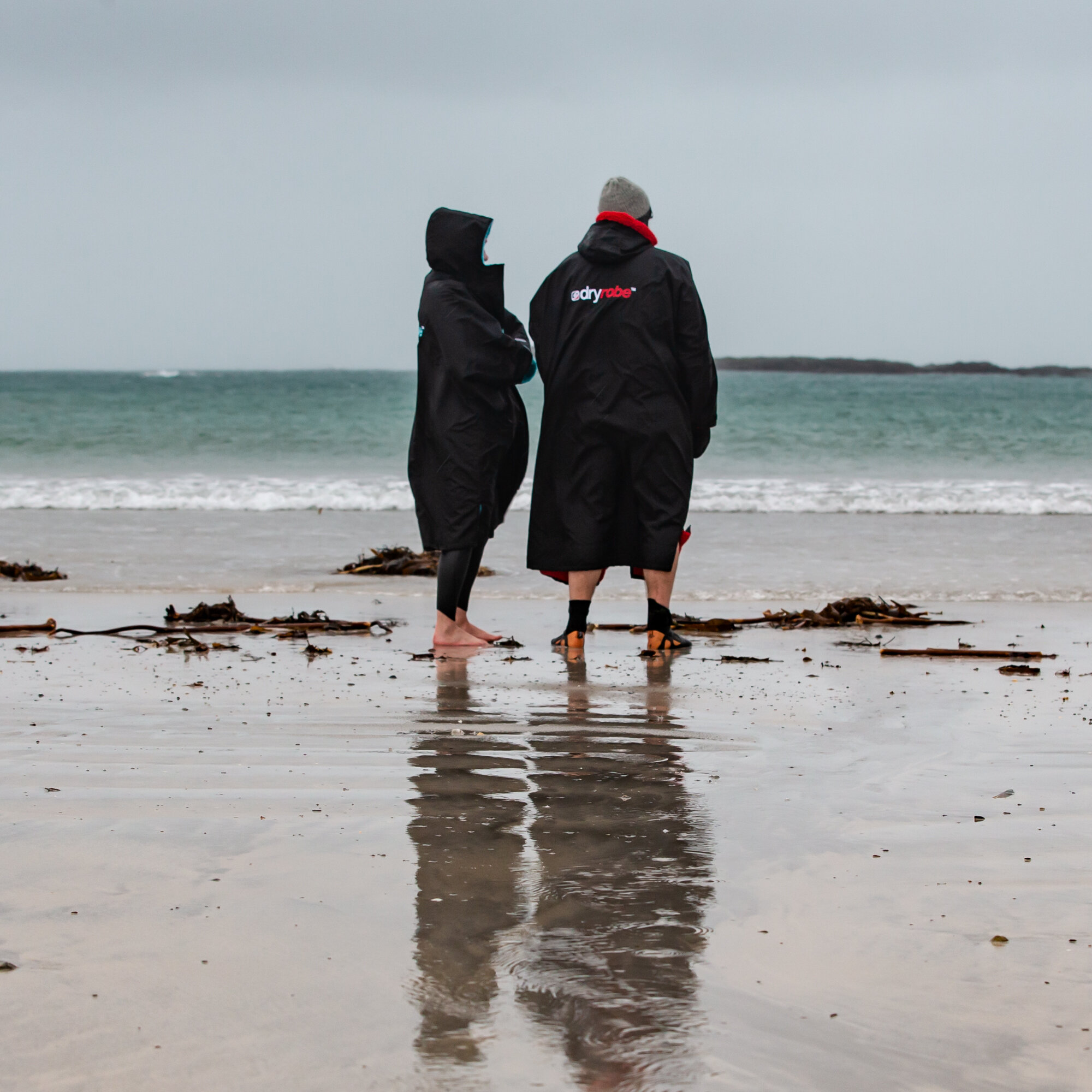How To Keep Your Head Warm Wild Swimming: A Solution That Really Works
1st January 2019, the day I first asked myself the question; How can I keep my head warm wild swimming. Because, that was the day I headed out on my first wild swimming adventure in the Atlantic Ocean. However, with my first adventure came my first surprise. Ice-cold brain-freeze. A totally unexpected and serious challenge to overcome. So much more severe than anything I'd experienced before.
Why? Because we’d moved to the Isle of Tiree, a small Scottish Island off the west coast of Scotland. And, this little paradise island sits in the Atlantic Ocean. Time for some research and a solution. It turns out, more testing than I thought I’d ever have to do to find a solution that really works for me.
A year later and my go to solution for keeping my head warm wild swimming, the one that really works for me, is a simple double layer pure raw wool hat. It’s a hygroscopic insulator, repels moisture and, if needed, soaks up 30% of its weight in water. But here’s the bonus, it won’t feel wet if it does need to soak up water. And more importantly it stops the heat escaping, by default, keeping my body warm in the depths of winter when I’m wild swimming in 5°C water without a wetsuit.
Keeping Your Head Warm Wild Swimming
I thought it important to clear something up. Personally, I see wild swimming as a little different to open water/outdoor swimming. For me wild swimming is more about the wild than it is the swimming. The swimming is just a byproduct of enjoying everything going on above and below the waterline. It feels to me that open water swimming or outdoor swimming is more about the swimming and it just happens not to be in a covered pool.
The reason I felt the need to put some context to this is simple. When I swim, the times I train for 4K or 5K either in a covered pool or open water, it’s all about head down and hit a goal of some sort. Speed, distance, stroke, and lots of thinking about the very immediate physical me.
Most of the time my head position is to some degree either in the water, or in a state of heading back into the water. However, when I’m wild swimming in the middle of winter in 5°C water without a wetsuit I could not be further from the swimmer me, so keeping my head warm is front of mind.
“an equilibrium is found between my body and the water,”
Wild swimming to me is all about the experience of the water and the things around me. It’s about knowing that in those first few seconds my body just does not know what to do in this cold and hostile place. But 2 minutes later, from my neck down, an equilibrium is found between my body and the water, apart from my head. There is a warmth that permeates my suspended body.
The moment at which this point of equilibrium is found for me is addictive. But, throughout the entire wild swimming experience my head is always above the waterline. And here in lies the biggest point of difference for me between wild swimming and other swimming done outside. It’s why the solution for keeping my head warm whilst wild swimming turns out to be so completely different. It really needs to work.
How Did I Find A Solution That Really Works For Me?
You’re probably saying to yourself “he should have known he was going to get brain freeze wild swimming - of course he’s going to get a cold head”. You are so right, what was I thinking!? Or rather, why wasn’t I thinking before heading out? To be honest it was because I thought to myself my head’s going to be above the water, so I’ll be fine.
The shock to the system was more about the instantaneous speed at which the cold hit. So fast and regardless of the things I tried, the brain freeze would not go away. Even when my body felt great. In-fact it just got worse as my body under the water felt even better.
I had to find a solution that really worked for me. I thought to myself, as I walked back to my car wrapped up in my dryrobe, this should be easy to solve. I could not have been more wrong. Keeping my head warm whilst wild swimming would prove to be an interesting journey of discovery.
I, as many of us do, reverted to type when solving new challenges. It’s the easy default. And to start with grabbed a swimming cap or two from my gear bag. This turned out to be the first of many failed attempts to find a solution that real worked for me.
What Will Keep Your Head Warm?
I ended up trying many more potential head warming doodads than I thought I'd need to. But I kept going to find a solution that really worked for me. Here’s an abridged list of some of the solutions I worked my way through each tried and test out wild swimming:
Swimming Cap – Silicone
Swimming Cap - Latex
Neoprene
Neoprene With A Liner
Acrylic Knitted Hat
Machine Processed Wool Hat
Hand Made Raw Wool Hat
I would suggest if you’re thinking about keeping your noggin warm ask yourself: do you prefer swimming in rivers, lakes plunge pools, waterfalls, coastal pools and hidden coves and coastlines? And do you enjoy the experience of just being in that place or space, taking in everything around you above and below the waterline? If you do, like me, you love wild element of the experience. The swimming part of things is just a means to an end. So, there is a very good chance your head will be bobbing around on the surface.
Swimming Cap Silicone or Latex
My first attempt at matching my head’s experience of wild swimming to that of my lower body experience of wild swimming, a swimming cap. It made total sense as I have loads of them from my many hours swimming training. But, for this they just didn’t work. Apart from being a pain to put on and take off they just felt wrong and my head, although not as cold, was still Mr Whippy’ish. But a dry head in one of these is a certainty above and below the water. For me it felt too restricting and I was all too aware of it being stuck to my head and dulling my hearing. I’m sure for some it’s a perfectly good compromise. They make total sense if you are out doing a the head down and blast out a couple of K. But when it’s more about just being in the moment it just felt wrong for me.
Neoprene Swim Hat
Neoprene is a good bet. I have two: a sort-of-cap-thing and one with a fleece lining and a chin strap. To me, yes it worked, a bit of a pain to put on but way better than the swimming caps. And, yes it did keep my head toasty warm. A good start but, and I know this will sound odd. It just felt wrong. Almost constricting or constraining, especially the one with the chin strap as it completely covers your ears so I can’t hear the wild part of wild swimming. And, because it’s not breathable on a number of occasions I felt like I needed to take it off to feel comfortable. This is a great option if you are going for a long artic freestyle or fly swim a winner but not a chance of getting cold in one of these. and with the chin strap its not going to come off if you dive down a little deeper.
Acrylic Knitted Hat
This was my first massive leap of faith. A Knitted hat, it just seemed wrong. But many people seem to wear them so there must be something in it. It can’t just be a fashion statement. Well to my surprise the best solution to that point. It was something I didn’t have to think about. Out of the car, walk to the water, wild swim, warm head and back to the car and home. All without the hat being removed. Had I found my holy grail? Simple answer almost. My one issue was when the hat became damp or even wet it just became an issue and seemed to lose some of its thermal values, not to mention a little strange to wear. But I felt this was getting close.
A little more research and...
Wool Knitted Hat
Put simply it felt like I’d hit the jackpot. All the benefits I’d discovered with the Acrylic, but it just seemed to me to be a little better and even when it did get wet for some reason it didn’t feel wet. It turns out because It’s a hygroscopic insulator, repels moisture and, if needed, soaks up 30% of its weight in water. But here’s the bonus, it does not feel wet if it soaks up water. So as with the acrylic hat; out of the car, walk to the water, wild swim, warm head and back to the car and home. All without the hat being removed. Well problem solved for me – so I thought. However, I was down the warm head rabbit warren and could not help but see if there was something else out there.
It turns out there is...
Raw Pure New Wool Knitted Hat
Raw pure new wool is the stuff made and used by people who really understand the benefits of wool it tends to retain lanolin which is, more-often-than-not, removed in mass-production wool processing. Lanolin improves the way in which wool repels moisture. I discovered that wool’s inner layers attract water, while its outer layers repel it, meaning wool can get wet and keep you insulated and feeling dry. If like me, you wild swim in both the summer and winter that’s a bonus.
It turns out that pure new wool has insulating properties which conform to its surroundings. Basically, wool keeps you warm when it’s cold, and cool when it’s hot. All because of its breathability and the way it creates micro-air pockets between the hat and your head. And that is why a pure new raw wool hat is my go-to for wild swimming. So much so we started making them for other swimmers and people who wanted to keep their heads warm in winter.
Funny how a move to an island off the west coast of Scotland, a New Year's Day wild swim and brain freeze can change everything.
Conclusion
Wild swimming, to me, is all about the experience of the water and the things around me. Maintaining a warm head whilst wild swimming is an important element that enhances the enjoyment of the wild experience. Opting for a raw pure new wool hat achieved a warm head whilst in cold waters. It really does work. And, it’s all because of wool’s naturally occurring properties. It’s a sustainable solution that’s put a smile on my face in the coldest of waters and helped me just appreciate the wild around me. It also inspired us to start WELAN.










